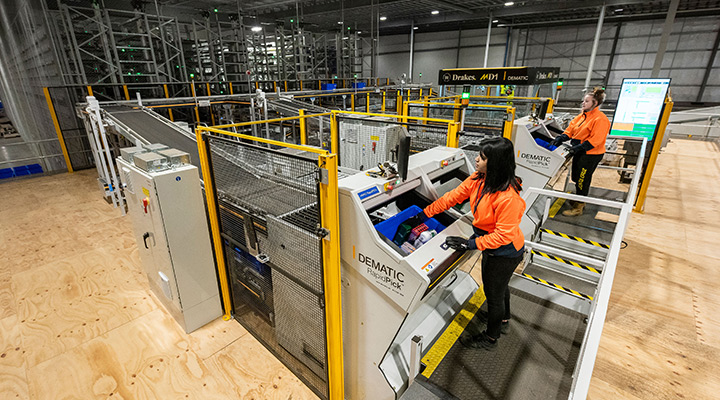Retailers worldwide are facing a trifecta of serious operational effectiveness and profitability challenges: a global supply chain crisis, surging inflation – impacting the cost of fuel, materials and storage costs – and rising labour rates.
These are impacting businesses at the same time as consumer demand is showing signs of returning to levels experienced before the advent of Covid-19 – and changing online shopping behaviour
Logistics expert Michael Bradshaw, senior director at Dematic, argues there has never been a more appropriate time for businesses such as retailers and wholesalers to review how they manage their distribution systems and practices.
“Automation and software can help businesses optimise their processes, people, inventory and information,” he explains to Inside Retail. “By increasing productivity, removing non-value-adding activities, reducing errors and increasing the speed of operations, businesses can better position themselves to handle the next change in conditions that will inevitably come. However waiting for that next chance to arrive before taking action, will severely limit the actions that can be taken.”
Bradshaw says for many years logistics and distribution companies have been apt to treat automation as a journey, initially investing in what he describes as “mechanisation” or “islands” of automation, focused on a single application, such as storage, order picking, or transport.
“As they grew and became more experienced with automation, they began to invest in more integrated systems with a higher level of automation, technology and software. However, advances in automation during recent years have completely turned this paradigm around and allowed companies to invest in more integrated solutions right from the start of their journey.”
This change has been welcomed by businesses who are faced with serving ever-more demanding customers – and, in turn, end consumers – who expect competitive prices, shorter lead times, and orders delivered in full, on time, and often more frequently. Online shoppers expect real-time information about the inventory of products they are ordering – and real-time status on the progress of their orders.
“In addition to facing the challenge of higher service levels, businesses have to contend with increasing labour costs, high staff turnover, increasing land and building costs, and pressures from increased regulation and safety requirements,” says Bradshaw. “The rapid growth in e-commerce triggered by the pandemic and other recent geopolitical developments have amplified these challenges.”
How automation and optimisation are meeting these challenges
Optimisation of warehouse and logistics processes is a key weapon for businesses to address these challenges, he explains. And they come in three core categories: processes, human and inventory.
Processes provide the structure for supply chains to function. There is a need for companies to continuously review and optimise processes as a way of increasing productivity, removing non-value adding activities, reducing errors, and increasing the speed of operations. This includes:
- Streamlining processes to eliminate touches – the number of times workers need to handle a product.
- Reducing operator travel – a major task in manual picking operations, which adds no value.
- Combining processes, such as batch-picking products for multiple orders or doing stock-take checks while picking.
- Introducing checks and balances to optimise efficiency and quality control.
Optimising human activity in the logistics and supply-chain process can assure their time is better used, increasing both the speed and accuracy of processing.
“Opportunities for optimisation become available when you know how, when and how often tasks are performed,” says Bradshaw. “From here, you can streamline processes, reduce effort, limit the number of touches, improve operator ergonomics, reduce training time for new users, and improve the overall worker environment.”
Just one of the examples he cites is the use of technology to provide real-time instructions to workers using options ranging from light-directed displays to wearable technology such as or audio headsets with voice recognition. The use of system-directed technology can increase speed, accuracy, operational visibility, labour management, back-office productivity and ergonomics by removing the need for operators to handle the paperwork.
In terms of automation, Goods-to-Person picking solutions can increase operator productivity by more than five times, and advances in robotic fulfilment technology have enabled order fulfilment processes to be performed without the involvement of operators at all.
The needs of retailers and wholesalers for storing inventory are constantly changing, which means efficiency and movement need to be reviewed continuously.
“Inventory storage has transitioned from being a static requirement to a dynamic one, with many supply chains now able to drive high levels of optimisation across not only their logistics operations, but their retail operations as well.” he adds. “Automation and technology often play a key role in achieving these high levels of optimisation”.
Manual forklift trucks and Automated Storage Retrieval Systems (AS/RS) are no longer the only material-handling technologies that can be used to store inventory. Technologies such as Automated Guided Vehicles (AGVs) and mobile robotic and shuttle systems can provide much more flexible, scalable and dynamic storage solutions in a much wider range of supply chain facilities. The new online shopping trend of click-and-collect has actually seen retail stores evolve into dynamic warehouses, and even delivery trucks have become “warehouses on the road”.
Optimising inventory with automation and technology offers the benefits of:
- Ability to identify where inventory is required, and the capability to move it there responsively.
- Improved use of network building assets to maximise storage capacity – for example, by increasing storage density and more effectively using headroom.
- Optimising stock accessibility and the speed with which customer orders and transfer orders can be fulfilled.
- Optimising the balance of centralising inventory to achieve efficiencies of scale and appropriate levels of ‘safety stock’, while locating sufficient stock close to consumers to improve delivery speeds and meet service levels.
- Reduced inventory holding and handling costs.
The importance of optimisation
Optimisation of logistics operations is all about analysing information relating to processes, human factors and inventory. By using analytic tools, wholesalers and retailers have a pathway to continuously improve their warehouse environments, through such steps as eliminating tasks that do not add value to the process, minimising unnecessary space and reducing errors.
New logistics automation and technologies provide a seamless interface between humans, products, automation, robotics, big data and operational visibility, maximising performance and responsiveness to operational and customer demands. Robust and real-time integration between software platforms across the supply chain, and within the operation – such as ERP, warehouse management, execution and control systems – is key.
Solution strategies in detail
Dematic has produced a white paper for businesses called Automation Strategies for Distribution Success which explains how its automation and software solutions work, including case studies for companies, including Woolworths, Lion Beer and Zara.
The report covers:
- Software.
- RF and voice technology.
- ‘Put walls” – an efficient way that reduces handling when processing orders that require individual items to be picked, packed and shipped.
- Conveyor systems.
- Automated Guided Vehicles.
- Automatic storage and retrieval systems.
- Multishuttle systems.
- Goods-to-Person, which allows picking and packing staff to stay in one place by delivering goods to them in the order they need them.
- Dematic’s storage buffer and order fulfilment solution, AutoStore.
- Sortation.
- Robotic picking.
- Mixed-case fulfilment.






